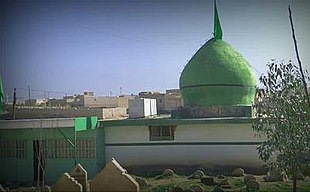
The Sanctuary of Imām 'Alī, also known as the Mosque of 'Alī, located in Najaf, Iraq, is a mausoleum which many Muslims believe contains the tomb of 'Alī ibn Abī Tālib, a cousin, son-in-law and companion of the Islamic prophet Muhammad. The Shī'as consider 'Alī as their first Imām, and the Sunnis regard him as the fourth Sunni Rashid Caliph. According to Shī'ite belief, buried next to 'Alī within this mosque are the remains of Adam and Nuh (Noah). Each year, millions of pilgrims visit the Shrine and pay tribute to Imām 'Alī.
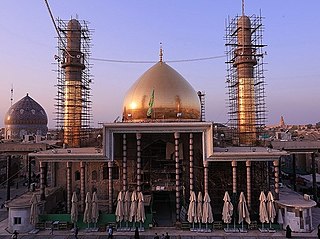
Al-Askari Shrine, the 'Askariyya Shrine or the Al-Askari Mosque is a Shia Muslim mosque and mausoleum in the Iraqi city of Samarra 125 km (78 mi) from Baghdad. It is one of the most important Shia shrines in the world. It was built in 944. The dome was destroyed in a bombing by Sunni extremists in February 2006 and its two remaining minarets were destroyed in another bombing in June 2007, causing widespread anger among Shias and instigation of the Iraqi Civil War between the country's Shia and Sunni factions. The remaining clock tower was also destroyed in July 2007. The dome and minarets were repaired and the mosque reopened in April 2009.
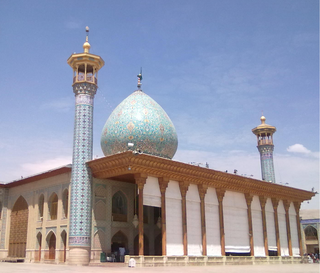
Shah Cheragh is a 12th century funerary monument and religious complex located in Shiraz, Iran. It is centred around the mausoleum of Sayyid Ahmad, the son of Musa al-Kadhim, who is known as Shah Cheragh in local traditions, and hence the building is named as such. The site is the 363th national monument of Iran.

A mazār, also transliterated as mazaar, also known as marqad (مَرْقَد) or in the Maghreb as ḍarīḥ (ضَرِيْح), is a mausoleum or shrine in some places of the world, typically that of a saint or notable religious leader. Medieval Arabic texts may also use the words mašhad (مَشْهَد) or maqām to denote the same concept.

The Al-Abbas Shrine is the mausoleum of Abbas ibn Ali and a mosque, located near the Imam Husayn Mosque in Karbala, Iraq. Abbas was son of Ali ibn Abi Talib and the half-brother of Imam Hasan and Imam Husayn. He was Husayn's flag-bearer in the Battle of Karbala and chief of his caravans. The shrine is revered by the Shia Muslims who visit it every year, especially in the month of Muharram.

Both Sunni Muslims and Shia Muslims agree on the three holiest sites in Islam being, respectively, the Masjid al-Haram, in Mecca; the Al-Masjid an-Nabawi, in Medina; and the Al-Masjid al-Aqsa, in Jerusalem.
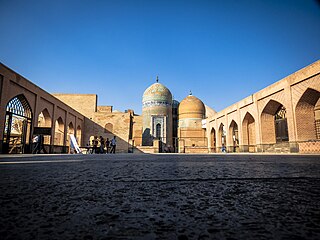
Sheikh Safi al-Din Khānegāh and Shrine Ensemble is the tomb of Sheikh Safi-ad-din Ardabili located in Ardabil, Iran. In 2010, it was registered on the UNESCO World Heritage List.

Tourism in Iraq refers to tourism in the Western Asian country Iraq. Iraq was one of the main destinations for many years, however it changed dramatically due to conflicts. The tourism in Iraq has faced many challenges, however, in recent years there has been improvements. The capital city Baghdad is the second largest city in the Arab world and the 4th largest in the Middle East. Iraq has several World Heritage Sites, dating back to ancient Mesopotamia, most notably Babylon Iraq. Iraq is considered to be a potential location for ecotourism. Erbil was chosen as "Arab Tourism Capital" in 2014 by the Arab Tourism Committee.

Al-Sayyida Nafisa Mosque or Mashhad al-Sayyida Nafisa is a mosque in al-Sayyida Nafisa district, a section of the larger historic necropolis called al-Qarafa in Cairo, Egypt. It is built to commemorate Sayyida Nafisa, a member of the household of the Islamic prophet Muhammad. The mosque has Sayyida Nafisa's mausoleum inside. Along with the necropolis around it, it is listed as part of the UNESCO World Heritage Site of Historic Cairo.

The Mausoleum of Abdul-Qadir Gilani, also known as Al-Ḥaḍrat Al-Qādiriyyah or Mazār Ghous, is an Islamic religious complex dedicated to Abdul Qadir Gilani, the founder of the Qadiriyya Sufi order, located in Baghdad, Iraq. Its surrounding square is named Kilani Square. The complex consists of the mosque, mausoleum, and the library known as Qadiriyya Library, which houses rare old works related to Islamic Studies. The son of the entombed scholar, Abdul Razzaq Gilani, is also buried there.

The Zumurrud Khatun Mosque and Mausoleum, also known as the Tomb of Sitta Zubayda, is a historic mosque and shrine located in Baghdad, Iraq. It dates back to the Abbasid era. It is located in Sheikh Maarouf Cemetery in the Karkh side of Baghdad, and the site was built at the patronage of Zumurrud Khatun and her son. Zumurrud Khatun was mother of the 34th Abbasid Caliph Al-Nasir, and wife of the 33rd Abbasid Caliph Al-Mustadi. She collected the waqf money from madrasas and built her mausoleum before her death, which is located in Karkh.
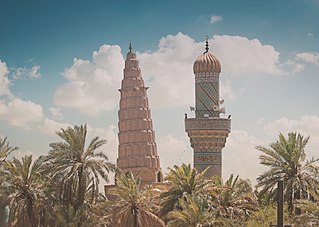
The Mausoleum of Umar Suhrawardi, or the Mosque and the Tomb of the Sheikh Umar Suhrawardi, is a historic complex of a mausoleum and a mosque, located in Baghdad, Iraq. The complex dates back to the Abbasid era and is dedicated to Shahab al-Din Abu Hafs Umar Suhrawardi, the founder of Suhrawardiyya Sufi Order. The mosque is located between the Sheikh Umar Street and Bab al-Wastani of the Baghdad wall, in the southern part of Al-Rusafa. The mosque can be overlooked from the Muhammad al-Qasim Highway and approximately one kilometre away from the city center.

Mausoleum of Yahya Abu al-Qasim was a historic shrine and mosque located in Mosul, Iraq. In 2014 the mosque and shrine were destroyed by an explosive device claimed by soldiers of the Islamic State of Iraq and Levant.

The Sheikh Jawad Al-Sadiq Mosque or Husseiniyah Mullah Mahmoud was a husseininya-mosque complex located in Tal Afar, Iraq. It is adjacent to the Saad Ibn Aqeel Shrine. The mosque of is named for the ninth Twelver Shi'a Imam, Muhammad al-Jawad and a Sheikh named Mahmoud al-Barzanji. There is also a small cemetery behind the mosque. The mosque is not to be confused with the Mosque of Sayyid Ar-Mahmoud.

Imam Saad bin Aqil' Shrine was a mosque, hussainiyah and mausoleum located at Tal Afar, Iraq. The complex contained the tomb of Imam Saad Bin Aqil, a descendant of Aqeel ibn Abi Talib. A smaller mausoleum with a white dome was located next to the mausoleum. Sheikh Jawad Al-Sadiq Mosque was next to the mosque and shrine. A few years later, a reconstruction started of the mausoleum.

Salman Al-Farsi Mosque is a mosque located in the village of Salman Pak in the Mada’in district, approximately 32 kilometres (20 mi) southeast of Baghdad, Iraq. It is one of the holy sites in Iraq. The shrine has historically been a Sunni mosque; however in more recent years it has been handed over to the Shia Muslims. The mosque is named after Salman al-Farsi, a companion of the Islamic prophet Muhammad, and contains his mausoleum.

The tomb of Sayyid ʿAlāʾed-Dīn Ḥusayn is a shrine in south-east Shiraz, Iran. Constructed in the 10th century of the Islamic calendar, the mausoleum houses the remains of Sayyid Ala'ed-Din Husayn, son of Imam Musa al-Kazim, and brother of Sayyid Ahmad. It is a tall building with a lofty dome. The original entrance was on the south side, approached by a small courtyard from the road that runs beside it. On the western side there is an area, more or less spacious, which was formerly a cemetery, but is now regarded as the western courtyard of the mausoleum.
Qubbat Sitnā Zaynab is a mosque and mausoleum located in Sinjar, in the Ninawa Governorate. The original mausoleum building was built in 1239 CE by Badr al-Din Lu'lu' as part of a ruling strategy to promote Shia Islam by sponsoring the erection of shrines and tombs dedicated to Imams throughout the Ninawa Governorate.
Al-Nabi Jirjis Mosque was a historic religious complex consisting of a mosque and mausoleum located in Mosul, Iraq. The person buried in the mausoleum is believed to be that of Saint George, known by Muslim locals as Jirjis.
The Shrine of Shaykh Fathi al-Mawsili is a religious complex located in Mosul, Iraq. The complex comprises a modern mosque and a 9th-century mausoleum which entombs the remains of Al-Fath al-Mawsili, an ascetic and Hadith transmitter. The current two buildings in the complex are modern, and were extensively reconstructed after they were demolished in 2014 by the Islamic State of Iraq and the Levant.
